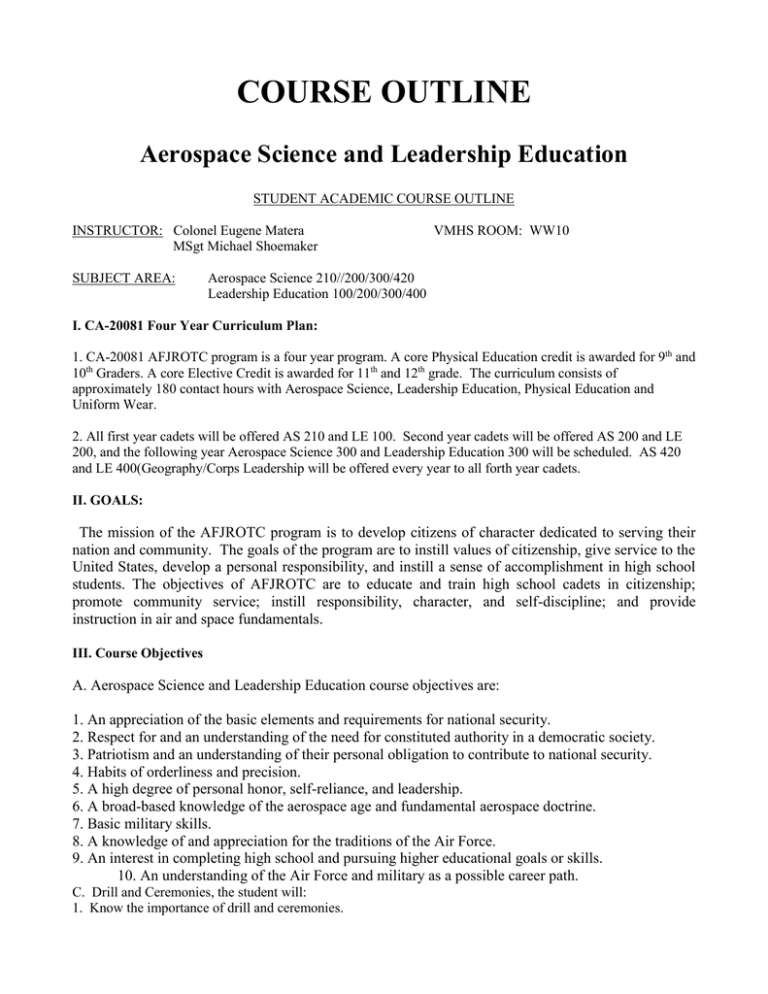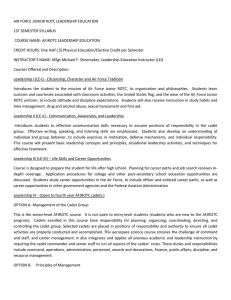COURSE OUTLINE Aerospace Science and Leadership Education
advertisement

COURSE OUTLINE Aerospace Science and Leadership Education STUDENT ACADEMIC COURSE OUTLINE INSTRUCTOR: Colonel Eugene Matera MSgt Michael Shoemaker SUBJECT AREA: VMHS ROOM: WW10 Aerospace Science 210//200/300/420 Leadership Education 100/200/300/400 I. CA-20081 Four Year Curriculum Plan: 1. CA-20081 AFJROTC program is a four year program. A core Physical Education credit is awarded for 9th and 10th Graders. A core Elective Credit is awarded for 11th and 12th grade. The curriculum consists of approximately 180 contact hours with Aerospace Science, Leadership Education, Physical Education and Uniform Wear. 2. All first year cadets will be offered AS 210 and LE 100. Second year cadets will be offered AS 200 and LE 200, and the following year Aerospace Science 300 and Leadership Education 300 will be scheduled. AS 420 and LE 400(Geography/Corps Leadership will be offered every year to all forth year cadets. II. GOALS: The mission of the AFJROTC program is to develop citizens of character dedicated to serving their nation and community. The goals of the program are to instill values of citizenship, give service to the United States, develop a personal responsibility, and instill a sense of accomplishment in high school students. The objectives of AFJROTC are to educate and train high school cadets in citizenship; promote community service; instill responsibility, character, and self-discipline; and provide instruction in air and space fundamentals. III. Course Objectives A. Aerospace Science and Leadership Education course objectives are: 1. An appreciation of the basic elements and requirements for national security. 2. Respect for and an understanding of the need for constituted authority in a democratic society. 3. Patriotism and an understanding of their personal obligation to contribute to national security. 4. Habits of orderliness and precision. 5. A high degree of personal honor, self-reliance, and leadership. 6. A broad-based knowledge of the aerospace age and fundamental aerospace doctrine. 7. Basic military skills. 8. A knowledge of and appreciation for the traditions of the Air Force. 9. An interest in completing high school and pursuing higher educational goals or skills. 10. An understanding of the Air Force and military as a possible career path. C. Drill and Ceremonies, the student will: 1. Know the importance of drill and ceremonies. 2. Know basic commands and characteristics of the command voice. 3. Apply and execute the concepts and principles of basic drill positions and movements. 4. Know when and how to salute. 5. Apply the principles and procedures of drill movements used with smaller units to the movement of a squadron. 6. Know the function of the group and the wing. 7. Know how groups and wings are formed. 8. Know the purpose and definition of ceremonies and parades. C: Physical Fitness/Wellness Activities On Thursdays and Fridays cadets will participate in physical activities that are designed to teach them to work together as a team to overcome adversity. These activities include stretches, sit-up, push-ups, standing long jump, short sprints, volley-tennis (volleyball game played on tennis court). In addition, touch football, softball and basketball will be played on an infrequent basis. Cadets are required to dress out in appropriate attire each week, participate in the warm up/stretching exercises and engage in the scheduled physical fitness event of the day. Failure to dress out and/or participate in scheduled activities, will result is a grade of zero being awarded. IV. TECHNIQUES AND METHODS OF INSTRUCTION A. B. C. D. E. F. G. H. I. J. Lecture/Discussion Guided discussion Text assignments Practical exercises Oral/written presentations Uniform inspections Drill and Ceremonies activities Physical fitness activities Audiovisual/Computer materials Special Considerations V. STUDENT EXPECTATIONS AND CONDUCT: 1. In addition to the rules of Vista Murrieta High School, each student is expected to follow the guidelines outlined in the CA-20081 AFJROTC Cadet Guide. 2. On-time class attendance is expected of each student. 3. Students are expected to come to class with all course materials, paper, and something to write with. 4. No food, drink, or gum is permitted in the classroom 5. Cadets are expected to display a positive attitude and exhibit exemplary behavior, at all times. VI. EVALUATION: The final grade for this course of instruction will be based on the student's performance in the following areas. 1. 2. 3. 4. 5. Aerospace Science – 25 % Leadership Education – 25% Physical Education – 30% Uniform Wear – 10% Drill – 10% VII. MISCELLANEOUS: A. Uniform Inspections 1. Wear of the AFJROTC Cadet Uniform is MANDATORY once a week to all classes. Improper or disrespectful wear of the uniform and/or not wearing the uniform to all classes on uniform wear day will result in an inspection score of zero. Guidelines for the wear of the uniform can be found in the CA-20081 AFJROTC Cadet Guide. The scheduling of a make-up uniform wear day is the sole responsibility of the student not the instructor. 2. Weekly uniform inspections will be conducted with a possible of 50 points for each inspection. The inspection will be conducted using the standards listed in AFI 36-2903 and AFROTCI 36-2001. These standards are listed in the CA-20081 AFJROTC Cadet Guide. The Cadet Inspection Checklist will be annotated with any discrepancies discovered during the inspection. B. Military Decorum 1. Your instructors will insist on promptness, preparedness, participation, self-control, and courtesy to others as the standards of behavior for classroom and group activities. 2. Cadet behavior and grooming standards must be maintained at the level expected of a member of a military organization. Each cadet is a representative of the Cadet Corps to the VMHS student body and the community and his/her appearance and behavior reflect on the entire AFJROTC organization. For this reason, our standards are much higher than those of the general VMHS student population. 3. All cadets will exercise self-discipline at all times, function as contributing member of the team, follow the instructions of cadets appointed over them, and show respect for authority. Cadet leaders are assigned specific responsibilities and rely on the willing cooperation and self-discipline of all cadets in their charge. D. End of Course Examination 1. The end of course examination will be completed at the end of the term grading period. It will include all topics covered during the term, to include all drill topics and commands. E. District Grading Scale: A 90-100 B 80-89 C 70-79 D 60-69 F Below 60 F. Homework/Make-up Policy 1. It is the student's responsibility to find out what work was missed due to class absence. 2. Course work is to be turned in on the day it is due. Late work will have points deducted. Workbooks will not be accepted after they are due. 3. Students are expected to be in uniform the first day back to class if they missed a required uniform wear day (refer to the CA-20081 AFJROTC Cadet Guide for further guidance). G. Tardy Policy 1. Students must be in the classroom when the tardy bell rings. 2. Students late to class unexcused stand a chance of missing important graded class work with no opportunity to make that grade up. On uniform wear days this will result in a reduction in the uniform inspection grade for failure to meet a formal formation.
